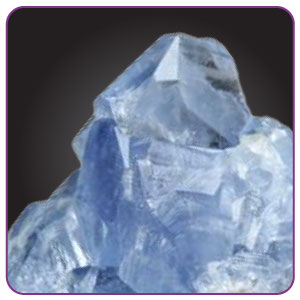Strontium

| Symbol | Sr |
| Atomic Number | 38 |
| Atomic Mass | 87.62 g.mol -1 |
| Discovered by | Adair Crawford in 1790 |

What is Strontium?
- Strontium belongs to the group 2 elements of the periodic table, along with Be, Mg, Ca and Ba.
Table of Contents
Chemical Properties of Strontium
| Group | 2 | Melting point | 777°C, 1431°F, 1050 K |
| Period | 5 | Boiling point | 1377°C, 2511°F, 1650 K |
| Block | s | Density (g cm−3) | 2.64 |
| Atomic number | 38 | Relative atomic mass | 87.62 |
| State at 20°C | Solid | Key isotopes | 86Sr, 87Sr, 88Sr |
| Electron configuration | [Kr] 5s2 | CAS number | 7440-24-6 |
| ChemSpider ID | 4514263 | ChemSpider is a free chemical structure database. | |
Uses of Strontium
-
-
-
- Although strontium is not considered as an essential element and does not have any known biological role, it is present in all living organisms.
- Strontium resembles the calcium element in its properties; like calcium, it is taken up and preferentially located in bones.
- Here, strontium can have both beneficial and deleterious effects in humans depending on the amount taken up.
- Strontium ranelate (C12H6N2O8SSr2 ), a pharmacologic agent used to treat individuals with osteoporosis, is indicated to be used in Europe and Australia but not in Canada or in the United States. Similar efficiency in the delivery of strontium to bones of animals was found for strontium citrate.
- Injectable acrylic bone cement is widely used in orthopaedic surgery to fix artificial prostheses. Conventional polymethylmethacrylate (PMMA) bone cement has been successfully used in arthroplasties of the hip, knee and other joints for the fixation of polymer or metallic prosthetic implants to living bone; however, it still has some potential problems and risks, such as poor adhesion of bone cement to the bone surface and high exothermic reaction during the polymerization
-
-
Properties of Strontium
-
-
-
- It has an atomic number of 38, an atomic mass of 88, one oxidation state (+2) and four naturally occurring isotopes (84Sr, 86Sr, 87Sr, 88Sr), of which 88Sr is the most abundant at 82.6% of the total mass.
- Strontium is most similar chemically to the heavier alkali earth elements, Calcium, and Barium.
- Strontium is a lithophile metallic element.
- The size of the Sr2+ ion (118 pm) is intermediate between those of Ca2+ (100 pm) and K+ (138 pm), for which it may substitute in a variety of rock-forming minerals including K-feldspar, gypsum, plagioclase and, especially, calcite and dolomite, which are the main sources of Sr in stream water.
- Some substitution for Ba also takes place in barite BaSO4 and witherite BaCO3.
- Minerals of Sr are relatively rare but include strontianite SrCO3 and celestite SrSO4, which are mainly associated with hydrothermal deposits or pegmatites.
- Strontium is strongly associated with calcium and is indicative of calcareous rocks, especially in association with Sr, Mg, and Ba. Where Ca and other elements indicate calcareous rocks and other elements (e.g., REEs) indicate felsic intrusives, bedrock geology may be favourable for skarn mineralization.
-
-

Comments